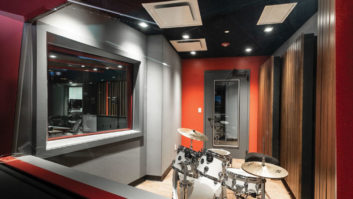
They say bands don’t sell records in the new Millennium, but since its major label debut in 2000, Papa Roach has sold 20 million albums around the globe. A lot of that is thanks to incessant touring, much as the band is doing for its new album, F.E.A.R., released this past January. Along for the ride on the inevitable world tour are engineers Eddie Mapp at front-of-house and Mike Lowe in monitorland.
Both have a history with the band—Mapp mixed Papa Roach on tour in 2005 and returned to the fold last fall, while Lowe took over the group’s monitor position in 2013. Planning for this year’s lengthy run—by the time you read this, they’ll be in Europe, having already done two U.S. runs as well as Australia, New Zealand and England— Lowe and Mapp aimed for continuity despite picking up local stacks and racks at each stop.
Papa Roach’s Jacoby Shaddix on Mics, COVID-19 Quarantine
“Last November, we both bought our own desks,” said Lowe, who has his own production company, ShotRock Productions. “Eddie and I handle all our own audio out here, so any purchases, we buy personally.” The engineers went with Midas consoles, with Lowe manning a Pro1 and Mapp getting a Pro2C, though he sometimes opts to rent another Pro1 instead, because as he noted, “We found some plastic-molded cases that they fit in, so they come in at 84 lbs—which means we have to pay overweight charges, but we can get it on a plane and carry our rig everywhere.”
The desks are networked together, with Lowe’s acting as the Master console. A Midas DL151 24-input stagebox takes everything from the stage, sending it into Lowe’s Pro1; those inputs, along with that desk’s own 24 inputs, are sent on further via AES50 protocol on Cat 5 cables to and from the FOH desk, giving both desks 48 channels for mixing. Fortunately, Mapp has room to grow: “This desk can have 40 channels plus effects returns. The band is at 32 channels, but I have another five channels that return to the desk—they’re triggers that open the sidechain of gates on my drums.”
Travelling light means that Mapp opts to stick with internal effects on the desk—which suits him just fine, thank you. “It keeps my show consistent no matter where I go, anywhere in the world; everything sounds great in there,” he said, diplomatically adding, “I think sometimes people complain about internal effects when maybe the source doesn’t sound good.”
Helping ensure he gets the sources he needs, Mapp supplies all his own mics for everything but vocals. “The drum kit stays bungeed down to the riser, so I just leave all my mics up and don’t have to worry about miking everyday. I have Audix D6s on the kick, rack tom and both floor toms—kind of oddball, but it’s the curve that I already use for EQing drums so I figure why not start there? We’ve also got a Shure Beta91A inside the kick drum that’s mounted on a Kelly Shu Flatz [Internal drum microphone support system]. Then I have sE Electronics sE5s for overheads and DPA 4099s underneath the hat and the ride cymbals. I’ve got a Telefunken M80SH on snare and an sE Electronics X1 D with a large titanium diaphragm, which is better for faster transients; Tony [Palermo], the drummer, plays with a lot of finesse, so there’s a lot of little ghost strokes and subtleties that would get missed otherwise.” Two channels of Tobin Esperance’s bass are on-hand, with a clean signal coming through a Rupert Neve Designs RNDI and a dirty one thanks to a Kemper modeling amp; meanwhile guitarist Jerry Horton’s signal comes from a Fractal Audio Axe FX II modeling amp.
Vocals from frontman Jacoby Shaddix, Esperance and Horton are captured with Audio-Technica AE6100 wireless mics and a helical antenna from PWS, with the backing vocals additionally passing through a Rupert Neve Designs 5045 primary source enhancer. Adding to the band’s RF footprint are JH Audio Roxanne ear buds on Sennheiser G3 wirelesses used by all members. “Today though, I’m using wedges for Jacoby because he has an ear infection,” said Lowe. “In-ears aren’t doing it for him because of pressure; he’ll start a song and with the ear infection, it’ll cut in half almost immediately. Part of the reason why everyone went off wedges in the first place was that everything was so loud; with in-ears, it’s safer, but with an infection, the source is close and you have to find that balance so that he doesn’t get hurt.”
As the ear infection shows, Papa Roach believes in the old maxim that the show must go on, but the audio team is just as committed to making that show sound the best it can. “What’s fun about having worked with this band before has been coming back and taking a fresh approach to it,” Mapp enthused. “I’m trying to make it as clean and coherent as possible and just portray that energy that they give. They’re a super in-your-face band and Jacoby is an incredible frontman, so I want big guitars and big drums and thunderous bass, but I also want those vocals to be clear and out front. It’s fun to close your eyes and be able to hear every word he’s saying. I look at it as a high-def version of Papa Roach for 2015.”
Midas
Midasconsoles.com





